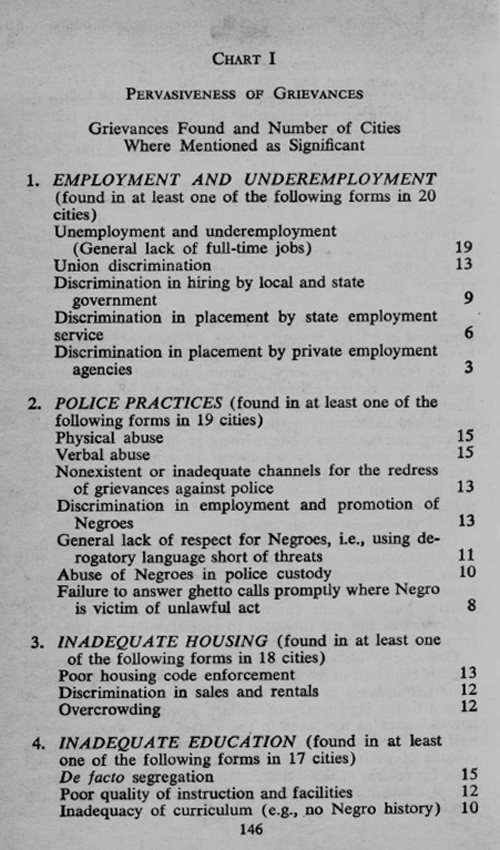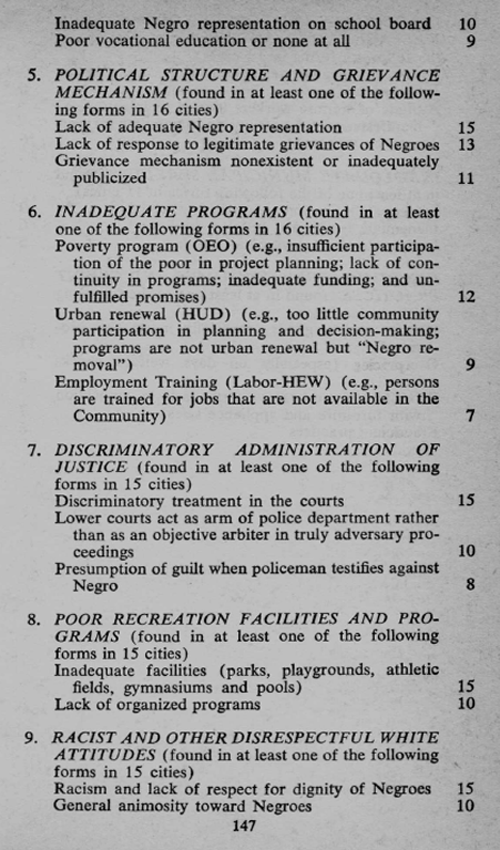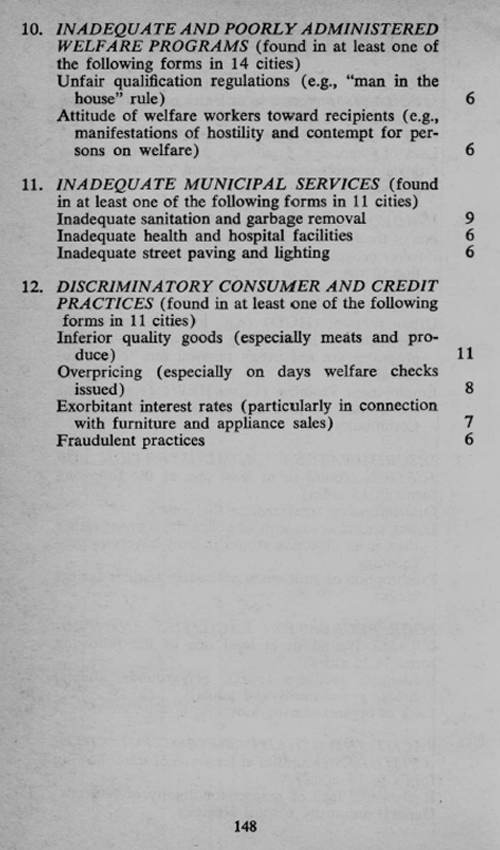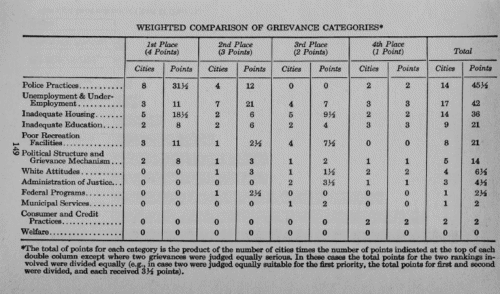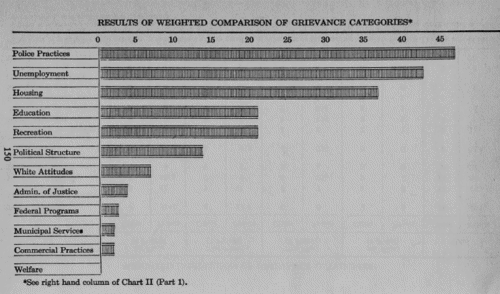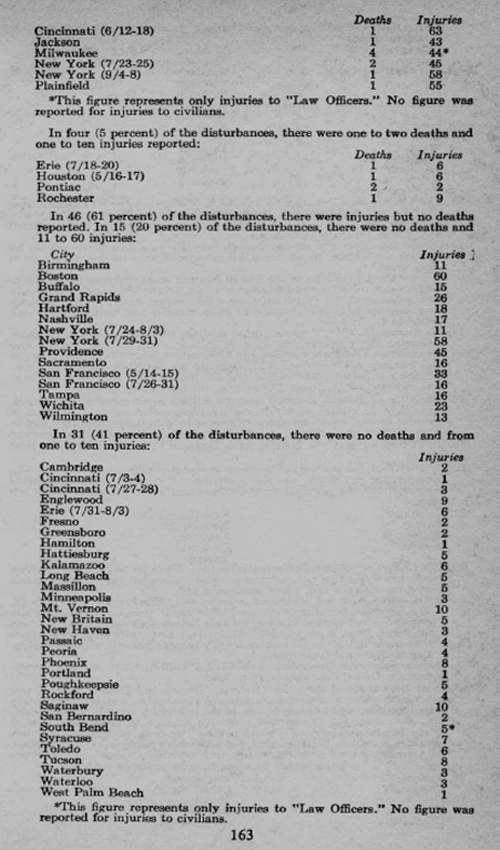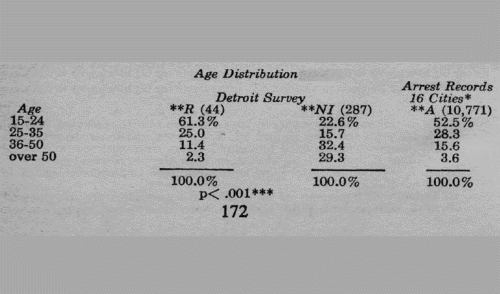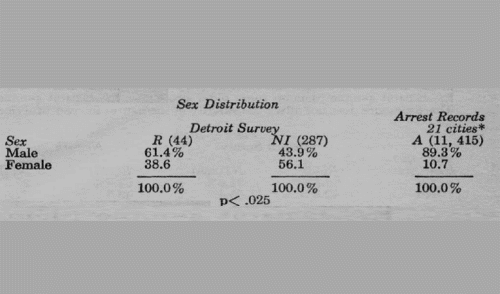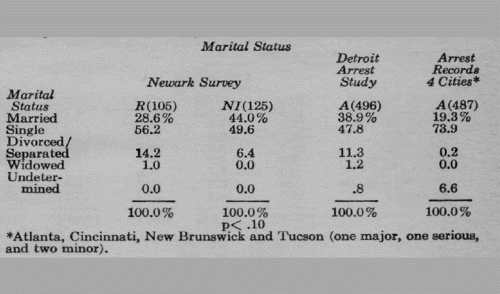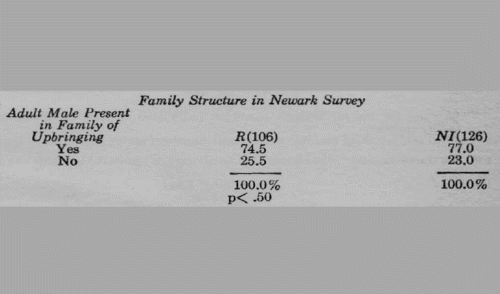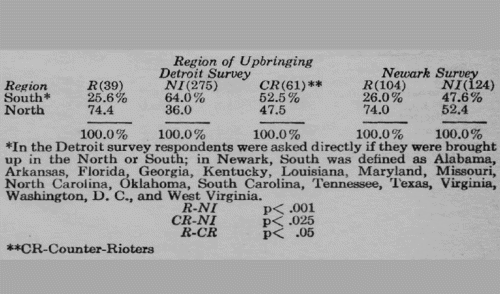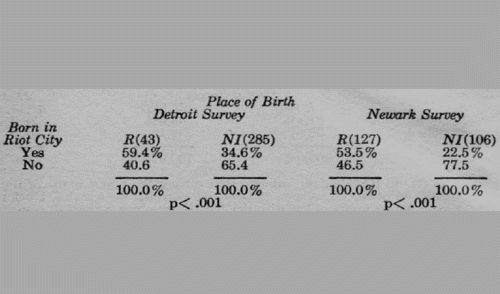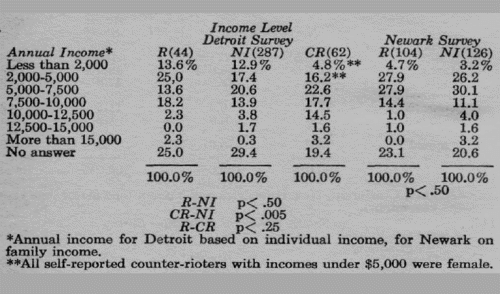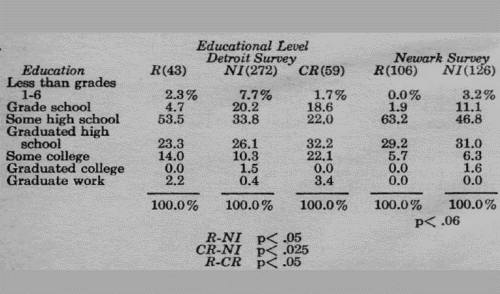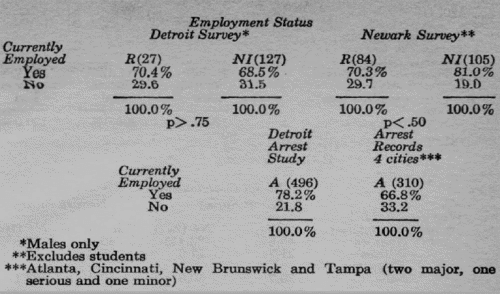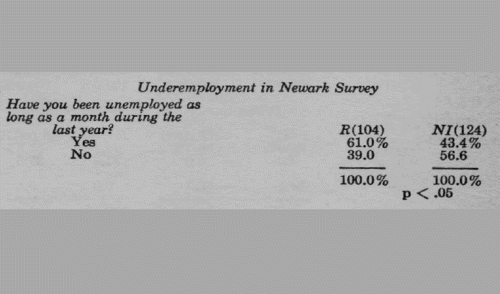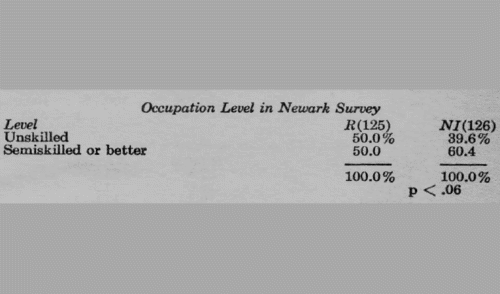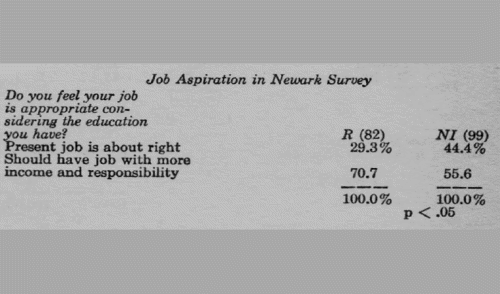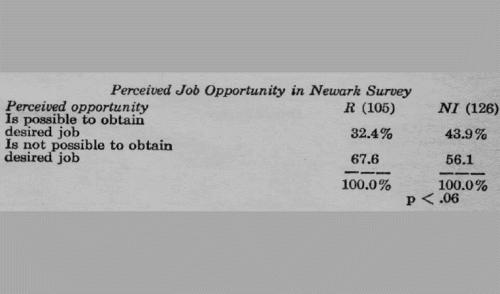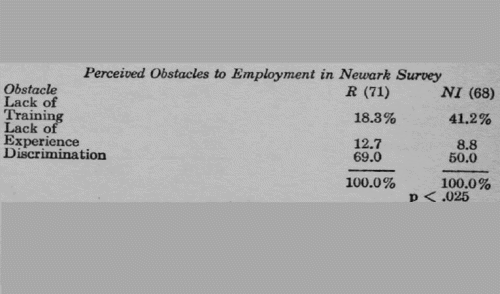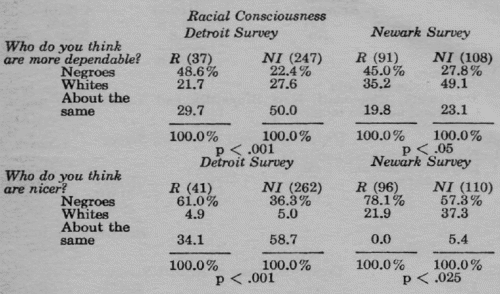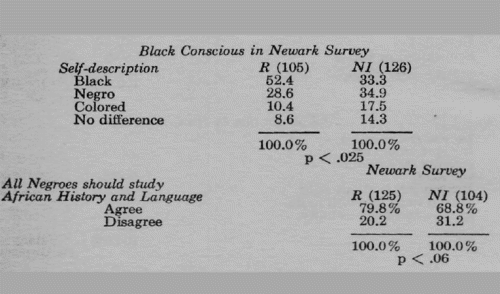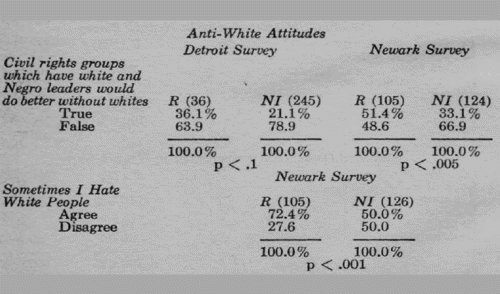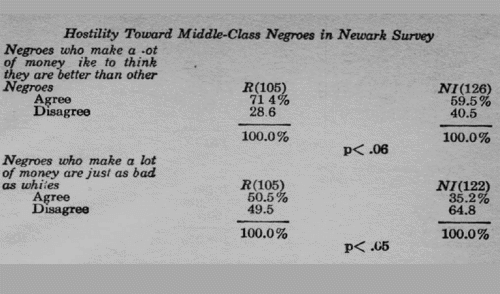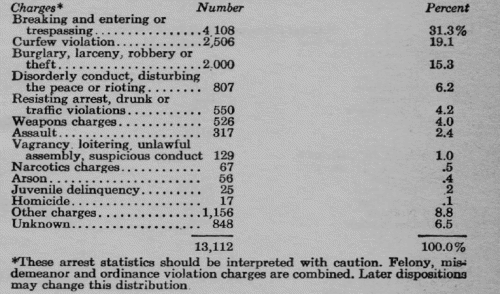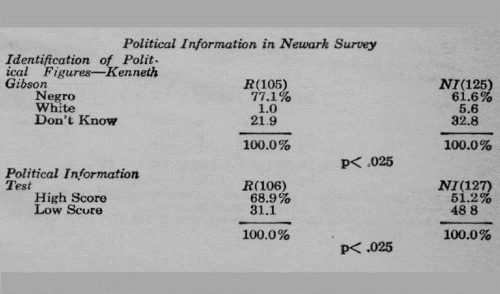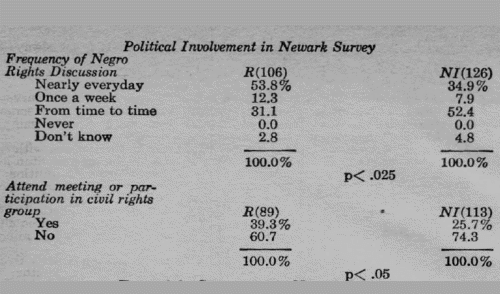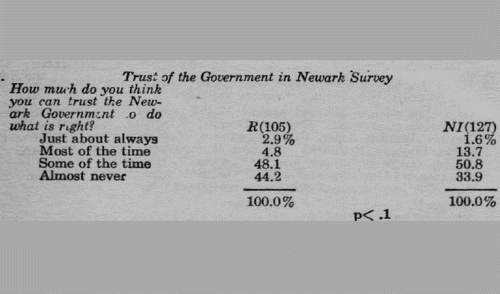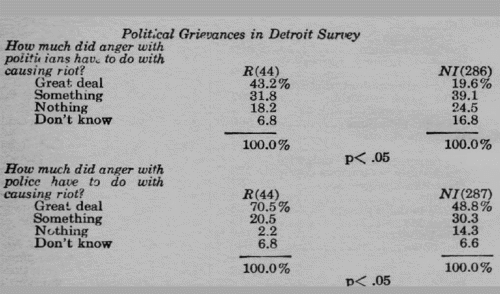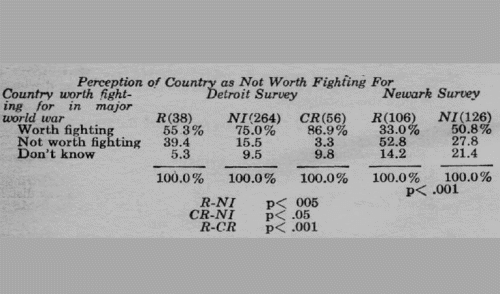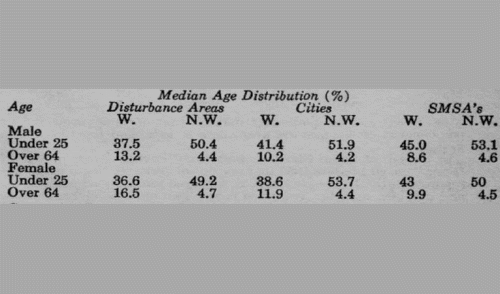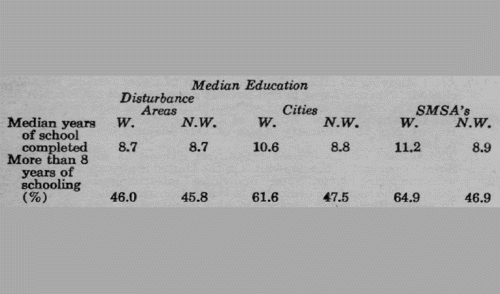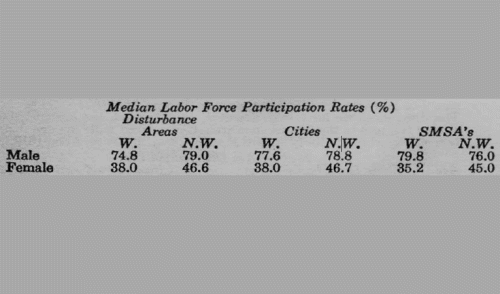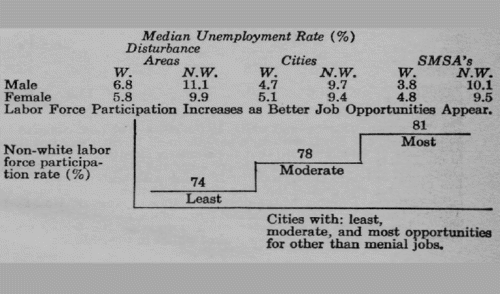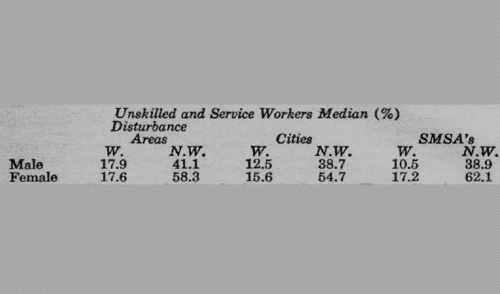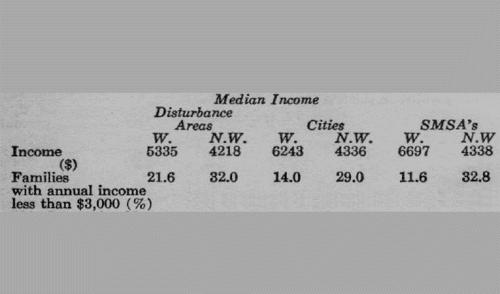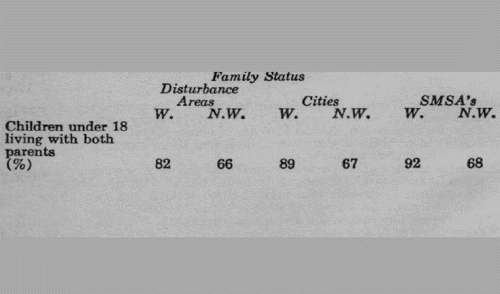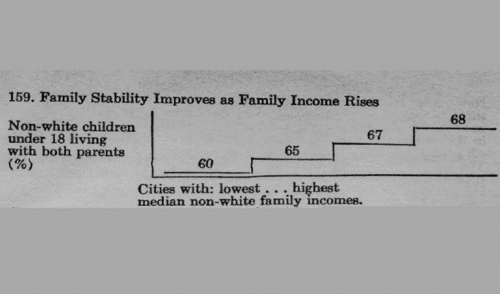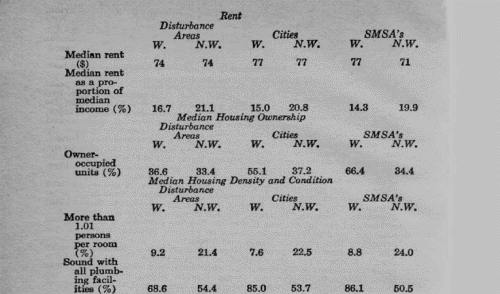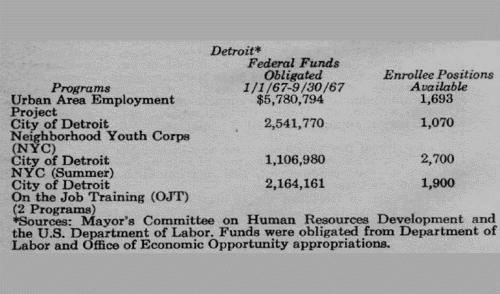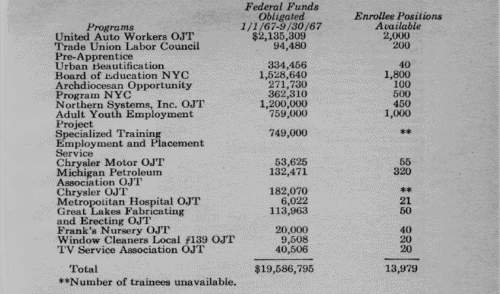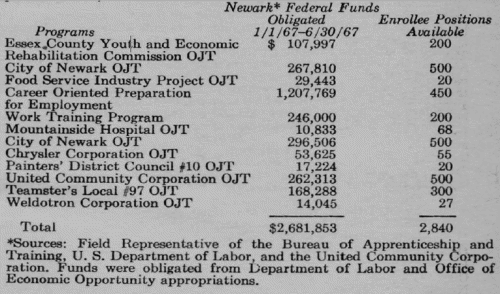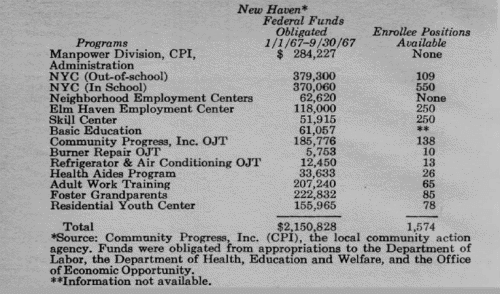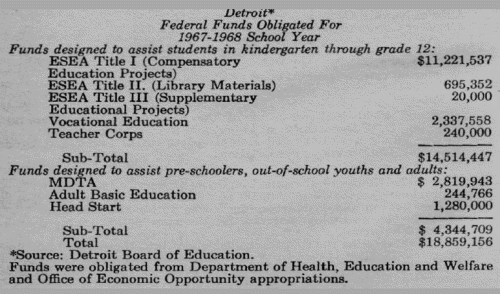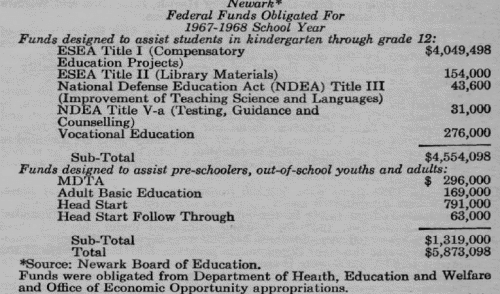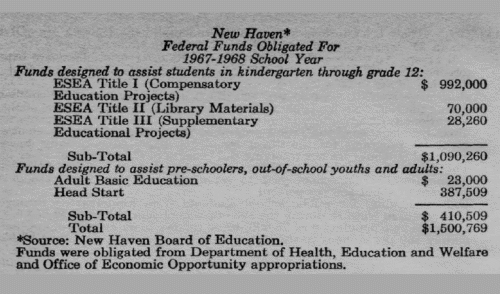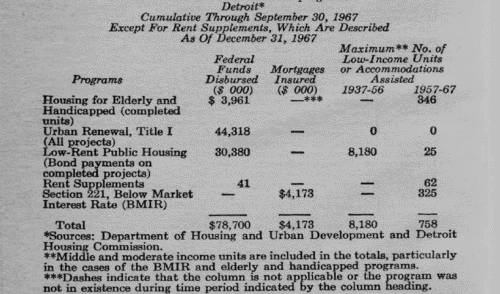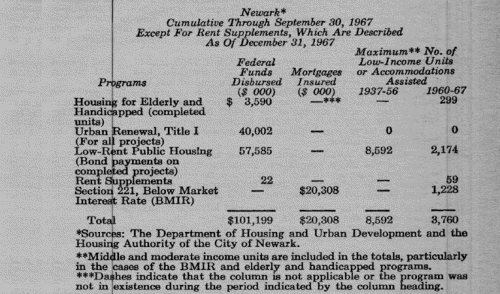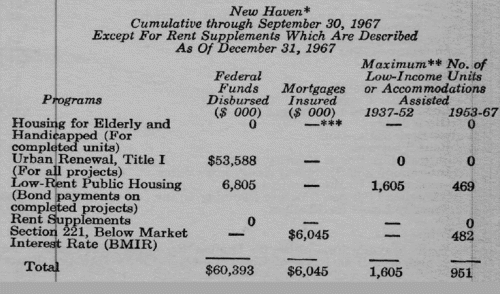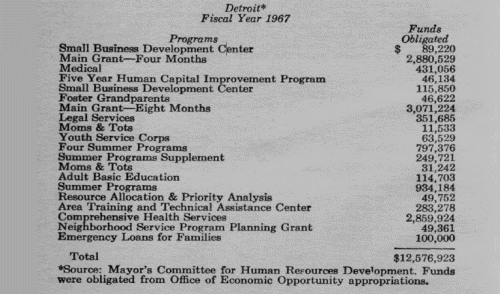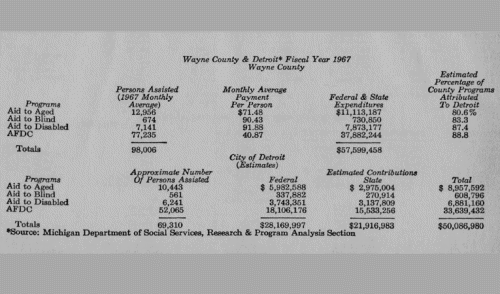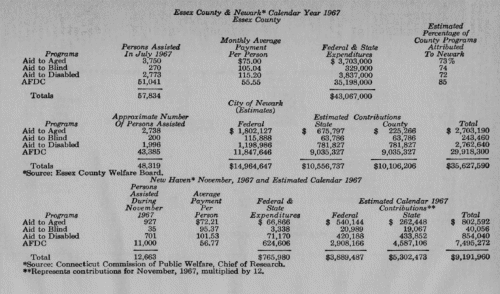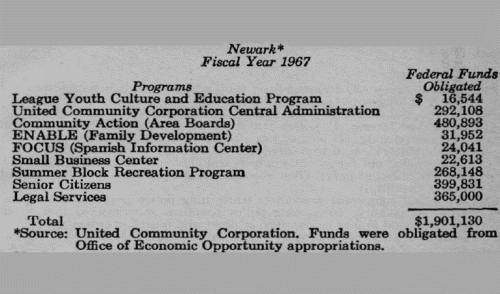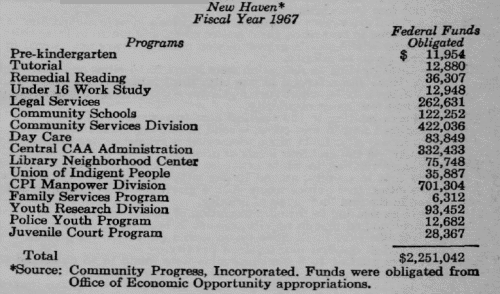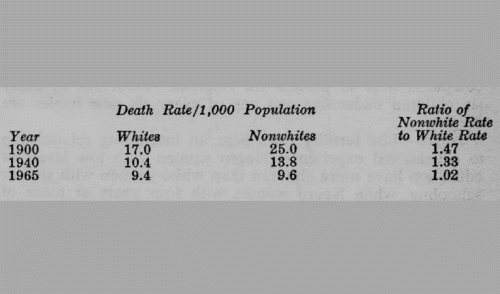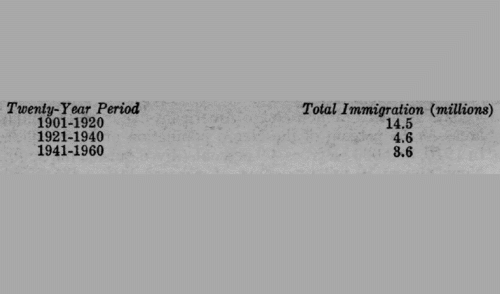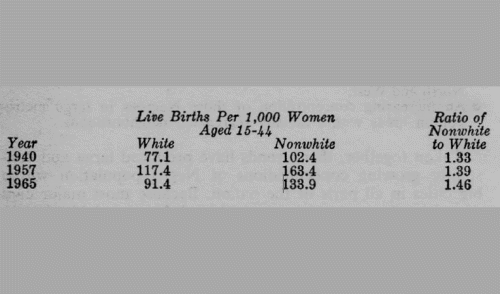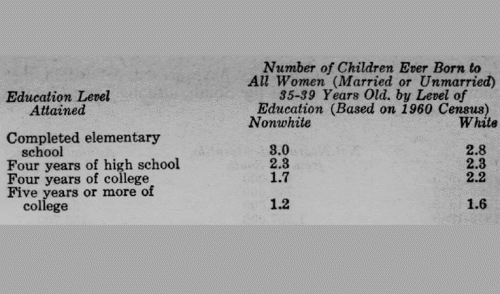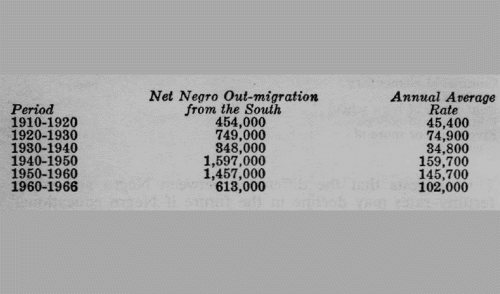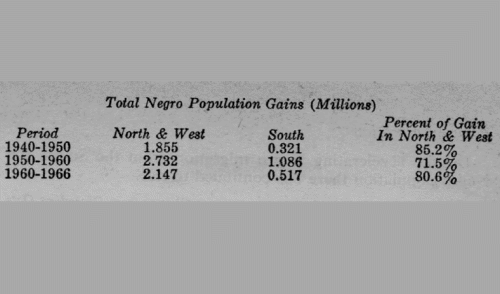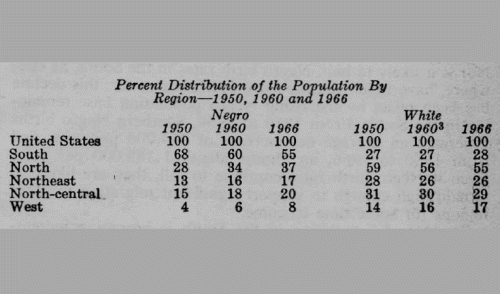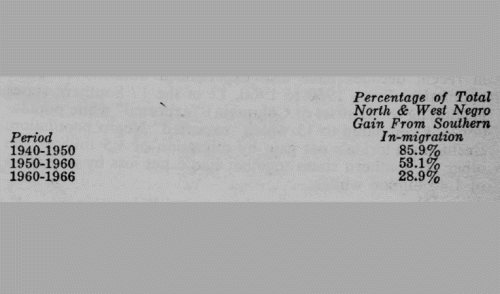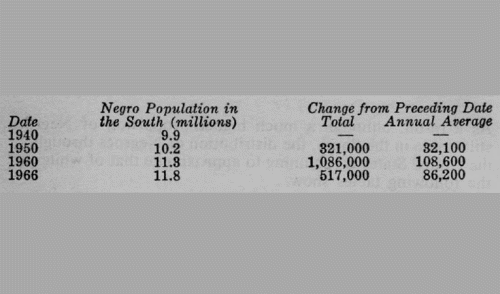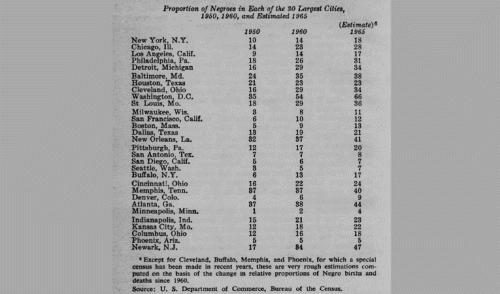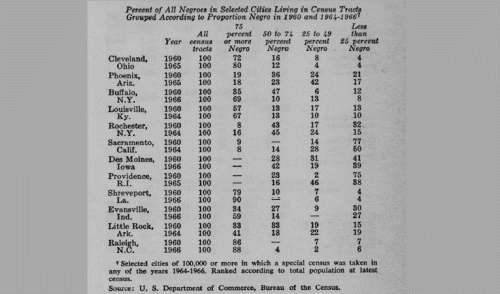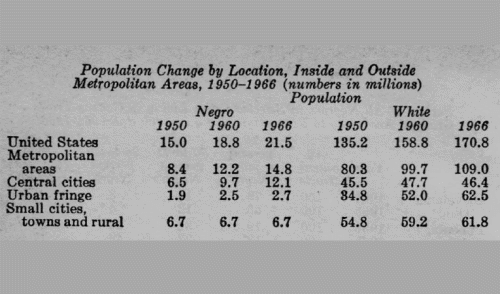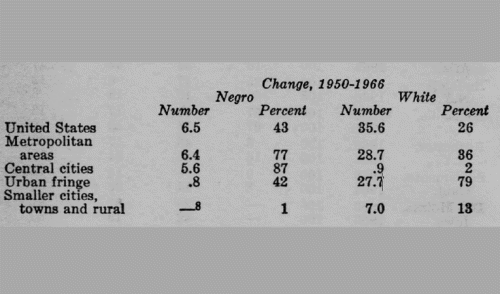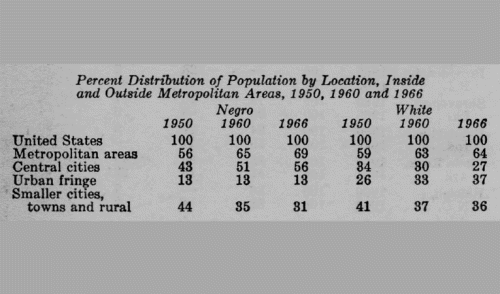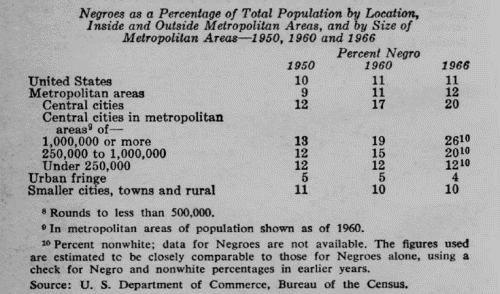Chapter 2: Patterns of Disorder [i]
INTRODUCTION
The President asked the Commission to answer several specific questions about the nature of riots:
• The kinds of communities where they occurred;
• The characteristics -- including age, education, and job history -- of those who rioted and those who did not;
• The ways in which groups of lawful citizens can be encouraged to help cool the situation;
• The relative impact of various depressed conditions in the ghetto which stimulated people to riot;
• The impact of federal and other programs on those conditions;
• The effect on rioting of police-community relationships;
• The parts of the community which suffered the most as a result of the disorders.
The profiles in the foregoing chapter portray the nature and extent of 10 of the disorders which took place during the summer of 1967. This chapter seeks in these events and in the others which we surveyed a set of common elements -- to aid in understanding what happened and in answering the President's questions.
This chapter also considers certain popular conceptions about riots. Disorders are often discussed as if there were a single type. The "typical" riot of recent years is sometimes seen as a massive uprising against white people, involving widespread burning, looting, and sniping, either by all Negroes or by an uneducated, Southern-born Negro underclass of habitual criminals or "riffraff." An agitator at a protest demonstration. the coverage of events by the news media, or an isolated ''triggering'' or "precipitating" incident is often identified as the primary spark of violence. A uniform set of stages is sometimes posited, with a succession of confrontations and withdrawals by two cohesive groups, the police on one side and a riotous mob on the other. Often it is assumed that there was no effort within the Negro community to reduce the violence. Sometimes the only remedy prescribed is application of the largest possible police or control force, as early as possible.
What we have found does not validate these conceptions. We have been unable to identify constant patterns in all aspects of civil disorders. We have found that they are unusual, irregular, complex and, in the present state of knowledge, unpredictable social processes. Like most human events, they do not unfold in orderly sequences.
Moreover, we have examined the 1967 disorders within a few months after their occurrence and under pressing time limitations. While we have collected information of considerable immediacy, analysis will undoubtedly improve with the passage and perspective of time and with the further accumulation and refinement of data. To facilitate further analysis we have appended much of our data to this report.
We have categorized the information now available about the 1967 disorders as follows.
• The pattern of violence over the nation: severity, location, timing, and numbers of people involved;
• The riot process in a sample of 24 disorders we have surveyed: [ii] prior events, the development of violence, the various control efforts on the part of officials and the community, and the relationship between violence and control efforts;
• The riot participants: a comparison of rioters with those who sought to limit the disorder and those who remained uninvolved;
• The setting in which the disorders occurred: social and economic conditions, local governmental structure, the scale of federal programs, and the grievance network in the Negro community;
• The aftermath of disorder: the ways in which communities responded after order was restored in the streets.
Based upon information derived from our surveys, we offer the following generalizations:
1. No civil disorder was "typical" in all respects. Viewed in a national framework, the disorders of 1967 varied greatly in terms of violence and damage: while a relatively small number were major under our criteria and a somewhat larger number were serious, most of the disorders would have received little or no national attention as "riots" had the nation not been sensitized by the more serious outbreaks.
2. While the civil disorders of 1967 were racial in character, they were not interracial. The 1967 disorders, as well as earlier disorders of the recent period, involved action within Negro neighborhoods against symbols of white American society -- authority and property -- rather than against white persons.
3. Despite extremist rhetoric, there was no attempt to subvert the social order of the United States. Instead, most of those who attacked white authority and property seemed to be demanding fuller participation in the social order and the material benefits enjoyed by the vast majority of American citizens.
4. Disorder did not typically erupt without preexisting causes, as a result of a single "triggering" or "precipitating" incident. Instead, it developed out of an increasingly disturbed social atmosphere, in which typically a series of tension-heightening incidents over a period of weeks or months became linked in the minds of many in the Negro community with a shared network of underlying grievances.
5. There was, typically, a complex relationship between the series of incidents and the underlying grievances. For example, grievances about allegedly abusive police practices, unemployment and underemployment, housing and other conditions in the ghetto, were often aggravated in the minds of many Negroes by incidents involving the police, or the inaction of municipal authorities on Negro complaints about police action, unemployment, inadequate housing or other conditions. When grievance-related incidents recurred and rising tensions were not satisfactorily resolved, a cumulative process took place in which prior incidents were readily recalled and grievances reinforced. At some point in the mounting tension, a further incident- -- n itself often routine or even trivial -- became the breaking point, and tension spilled into violence.
6. Many grievances in the Negro community result from the discrimination, prejudice and powerlessness which Negroes often experience. They also result from the severely disadvantaged social and economic conditions of many Negros as compared with those of whites in the same city and, more particularly, in the predominantly white suburbs.
7. Characteristically, the typical rioter was not a hoodlum, habitual criminal, or riffraff; nor was he a recent migrant, a member of an uneducated underclass, or a person lacking broad social and political concerns. Instead, he was a teenager or young adult, a lifelong resident of the city in which he rioted, a high-school drop-out -- but somewhat better educated than his Negro neighbor -- and almost invariably underemployed or employed in a menial job. He was proud of his race, extremely hostile to both whites and middle-class Negroes and, though informed about politics, highly distrustful of the political system and of political leaders.
8. Numerous Negro counter-rioters walked the streets urging rioters to "cool it." The typical counter-rioter resembled in many respects the majority of Negroes, who neither rioted nor took action against the rioters, that is, the non-involved. But certain differences are crucial: the counter-rioter as better educated and had higher income than either the rioter or the noninvolved.
9. Negotiations between Negroes and white officials occurred during virtually all the disorders surveyed. The negotiations often involved young, militant Negroes as well as older, established leaders. Despite a setting of chaos and disorder, negotiations in many cases involved discussion of underlying grievances as well as the handling of the disorder by control authorities.
10. The chain we have identified -- discrimination, prejudice, disadvantaged conditions, intense and pervasive grievances, a series of tension-heightening incidents, all culminating in the eruption of disorder at the hands of youthful, politically-aware activists -- must be understood as describing the central trend in the disorders, not as an explanation of all aspects of the riots or of all rioters. Some rioters, for example, may have shared neither the conditions nor the grievances of their Negro neighbors; some may have coolly and deliberately exploited the chaos created by others; some may have been drawn into the melee merely because they identified with, or wished to emulate, others. Nor do we intend to suggest that the majority of the rioters, who shared the adverse conditions and grievances, necessarily articulated in their own minds the connection between that background and their actions.
11. The background of disorder in the riot cities was typically characterized by severely disadvantaged conditions for Negroes, especially as compared with those for whites; a local government often unresponsive to these conditions; federal programs which had not yet reached a significantly large proportion of those in need; and the resulting reservoir of pervasive and deep grievance and frustration in the ghetto.
12. In the immediate aftermath of disorder, the status quo of daily life before the disorder generally was quickly restored. Yet, despite some notable public and private efforts, little basic change took place in the conditions underlying the disorder. In some cases, the result was increased distrust between blacks and whites, diminished interracial communication, and growth of Negro and white extremist groups.
I. THE PATTERN OF VIOLENCE AND DAMAGE
Levels of Violence and Damage
Because definitions of "civil disorder" vary widely, between 51 and 217 disorders were recorded by various agencies as having occurred during the first nine months of 1967. From these sources we have developed a list of 164 disorders which occurred during that period. [1] We have ranked them in three categories of violence and damage utilizing such criteria as the degree and duration of violence, the number of active participants, and the level of law enforcement response:
Major Disorders -- Eight disorders, 5 percent of the total, were major. These were characterized generally by a combination of the following factors: (1) many fires, intensive looting, and reports of sniping; (2) violence lasting more than two days; (3) sizeable crowds; and (4) use of National Guard or federal forces [2] as well as other control forces.
Serious disorders -- Thirty-three disorders, 20 percent of the total, were serious but not major. These were characterized generally by: (1) isolated looting, some fires, and some rock throwing; (2) violence lasting between one and two days; (3) only one sizeable crowd or many small groups; and (4) use of state police [3] though generally not National Guard or federal forces.
Minor disorders -- One hundred and twenty-three disorders, 75 percent of the total, were minor. These would not have been classified as "riots" or received wide press attention without national conditioning to a "riot climate." They were characterized generally by: (1) a few fires and broken windows; (2) violence lasting generally less than one day; (3) participation by only small numbers of people; and (4) use, in most cases, only of local police or police from a neighboring community. [4]
The 164 disorders which we have categorized occurred in 128 cities. Twenty-five (20 percent) of the cities had two or more disturbances. New York had five separate disorders, Chicago had four, six cities had three and 17 cities had two. [5] Two cities which experienced a major disorder -- Cincinnati and Tampa -- had subsequent disorders; Cincinnati had two more. However, in these two cities the later disorders were less serious than the earlier ones. In only two cities were later disorders more severe.
Three conclusions emerge from the data:
• The significance of the 1967 disorders cannot be minimized. The level of disorder was major or serious, in terms of our criteria, on 41 occasions in 39 cities.
• The level of disorder, however, has been exaggerated. Three-fourths of the disorders were relatively minor and would not have been regarded as nationally-newsworthy "riots" in prior years.
• The fact that a city had experienced disorder earlier in 1967 did not immunize it from further violence.
Time -- In 1967, disorders occurred with increasing frequency as summer approached and tapered off as it waned. More than 60 percent of the 164 disorders occurred in July alone.
Disorders by Month [7] and Level
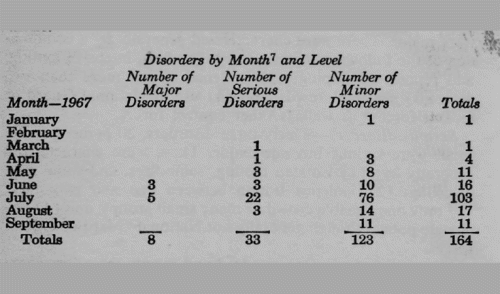
Space -- The violence was not limited to any one section of the country.
Disorders by Month [8] and Level
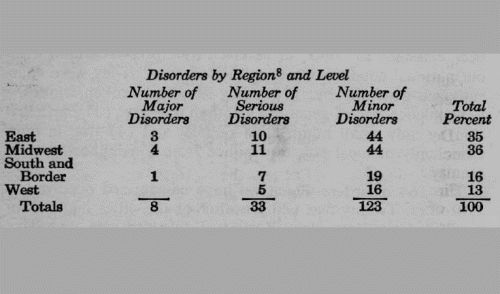
When timing and location are considered together, other relationships appear. Ninety-eight disorders can be grouped into 23 clusters, which consist of two or more disturbances occurring within two weeks and within a few hundred miles of each other.
"Clustering" was particularly striking for two sets of cities. The first, centered on Newark, consisted of disorders in 14 New Jersey cities. The second, centered on Detroit, consisted of disturbances in seven cities in Michigan and one in Ohio. [9]
Size of Community -- The violence was not limited to large cities. Seven of the eight major disorders occurred in communities with populations of 250,000 or more. But 37 (23 percent) of the disorders reviewed occurred in communities with populations of 50,000 or less; and 67 disorders (41 percent) occurred in communities with populations of 100,000 or less, including nine (about 22 percent) of the 41 serious or major disturbances.
Disorders by Level and City Population [10]
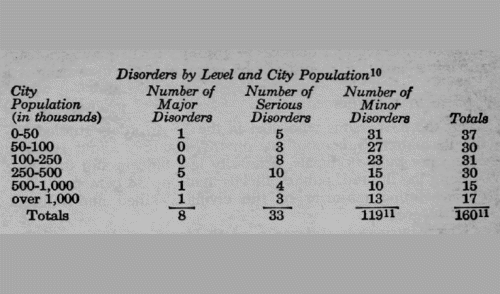
Death, Injury and Damage
In its study of 75 disturbances in 67 cities, the Permanent Subcommittee on Investigations of the Senate Committee on Government Operations reported 83 deaths and 1,897 injuries. [12 ]Deaths occurred in 12 of these disturbances. More than 80 percent of the deaths and more than half the injuries occurred in Newark and Detroit. In more than 60 percent of the disturbances, no deaths and no more than 10 injuries were reported. [13]
Substantial damage to property also tended to be concentrated in a relatively small number of cities. Of the disorders which the Commission surveyed, significant damage resulted in Detroit ($40-45 million), Newark ($10.2 million), and Cincinnati (more than $1 million). In each of nine cities, damage was estimated at less than $100,000. [14]
Fire caused extensive damage in Detroit and Cincinnati, two of the three cities which suffered the greatest destruction of property. [15] Newark had relatively little loss from fire but extensive inventory loss from looting and damage to stock. [16]
Damage estimates made at the time of the Newark and Detroit disorders were later greatly reduced. Early estimates in Newark ranged from $15 to $25 million; a month later the estimate was revised to $10.2 million. In Detroit, newspaper damage estimates at first ranged from $200 million to $500 million, the highest recent estimate is $45 million. [17]
What we have said should not obscure three important factors. First, the dollar cost of the disorder should be increased by the extraordinary administrative expenses of municipal, state and Federal governments. [18 ]Second, deaths and injuries are not the sole measures of the cost of civil disorders in human terms. For example, the cost of dislocation of people -- though clearly not quantifiable in dollars and cents -- was a significant factor in Detroit, the one case in which many residences were destroyed. [19] Other human costs -- fear, distrust, and alienation -- were incurred in every disorder. Third, even a relatively low level of violence and damage in absolute terms may seriously disrupt a small or medium-sized community.
Victims of Violence
Of the 83 persons who died in the 75 disorders studied by the Permanent Subcommittee on Investigation, about 10 percent were public officials, primarily law officers and firemen. Among the injured, public officials made up 38 percent. [20] The overwhelming majority of the civilians killed and injured were Negroes.
Retail businesses suffered a much larger proportion of the damage during the disorders than public institutions, industrial properties, or private residences. In Newark, 1,029 establishments, affecting some 4,492 employers and employees, suffered damage to buildings or loss of inventory or both. Those which suffered the greatest loss through looting, in descending order of loss, were liquor, clothing, and furniture stores.
White-owned businesses are widely believed to have been damaged much more frequently than those owned by Negroes. In at least nine of the cities studied, the damage seems to have been, at least in part, the result of deliberate attacks on white-owned businesses characterized in the Negro community as unfair or disrespectful toward Negroes. [21]
Not all the listed damage was purposeful or was caused by rioters. Some was a by-product of violence. In certain instances police and fire department control efforts caused damage. The New Jersey commission on civil disorders has found that in Newark, retributive action was taken against Negro-owned property by control forces. [22] Some damage was accidental. In Detroit some fire damage, especially to residences, may have been caused primarily by a heavy wind.
Public institutions generally were not targets of serious attacks, [23] but police and fire equipment was damaged in at least 15 of the 23 cities. [24]
Of the cities surveyed, significant damage to residences occurred only in Detroit. In at least nine of the 22 other cities there was minor damage to residences, often resulting from fires in adjacent businesses. [25]
II. THE RIOT PROCESS
The Commission has found no "typical" disorder in 1967 in terms of intensity of violence and extensiveness of damage. To determine whether, as is sometimes suggested, there was a typical "riot process," we examined 24 disorders which occurred during 1967 in 20 cities and three university settings. [26] We have concentrated on four aspects of that process:
• The accumulating reservoir of grievances in the Negro community;
• "Precipitating" incidents and their relationship to the reservoir of grievances;
• The development of violence after its initial outbreak;
• The control effort, including official force, negotiation, and persuasion.
We found a common social process operating in all 24 disorders in certain critical respects. These events developed similarly, over a period of time and out of an accumulation of grievances and increasing tension in the Negro community. Almost invariably, they exploded in ways related to the local community and its particular problems and conflicts. But once violence erupted, there began a complex interaction of many elements -- rioters, official control forces, counter-rioters -- in which the differences between various disorders were more pronounced than the similarities.
The Reservoir of Grievances in the Negro Community
Our examination of the background of the surveyed disorders revealed a typical pattern of deeply-held grievances which were widely shared by many members of the Negro community. [27] The specific content of the expressed grievances varied somewhat from city to city. But in general, grievances among Negroes in all the cities related to prejudice, discrimination, severely disadvantaged living conditions and a general sense of frustration about their inability to change those conditions.
Specific events or incidents exemplified and reinforced the shared sense of grievance. News of such incidents spread quickly throughout the community and added to the reservoir. Grievances about police practices, unemployment and underemployment, housing and other objective conditions in the ghetto were aggravated in the minds of many Negroes by the inaction of municipal authorities.
Out of this reservoir of grievance and frustration, the riot process began in the cities which we surveyed.
Precipitating Incidents
In virtually every case a single "triggering" or "precipitating" incident can be identified as having immediately preceded -- within a few hours and in generally the same location -- the outbreak of disorder. [28] But this incident was usually relatively minor, even trivial, by itself substantially disproportionate to the scale of violence that followed. Often it was an incident of a type which had occurred frequently in the same community in the past without provoking violence.
We found that violence was generated by an increasingly disturbed social atmosphere, in which typically not one, but a series of incidents occurred over a period of weeks or months prior to the outbreak. of disorders. [29] Most cities had three or more such incidents; Houston had 10 over a five-month period. These earlier or prior incidents were linked in the minds of many Negroes to the pre-existing reservoir of underlying grievances. With each such incident, frustration and tension grew until at some point a final incident, often similar to the incidents preceding it, occurred and was followed almost immediately by violence.
As we see it, the prior incidents and the reservoir of underlying grievances contributed to a cumulative process of mounting tension that spilled over into violence when the final incident occurred. In this sense the entire chain -- the grievances, the series of prior tension-heightening incidents, and the final incident -- was the "precipitant" of disorder.
This chain describes the central trend in the disorders we surveyed, and not necessarily all aspects of the riots or of all rioters. For example, incidents have not always increased tension; and tension has not always resulted in violence. We conclude only that both processes did occur in the disorders we examined.
Similarly, we do not suggest that all rioters shared the conditions or the grievances of their Negro neighbors: some may deliberately have exploited the chaos created out of the frustration of others; some may have been drawn into the melee merely because they identified with, or wished to emulate, others. Some who shared the adverse conditions and grievances did not riot.
We found that the majority of the rioters did share the adverse conditions and grievances. Although they did not necessarily articulate in their own minds the connection between that background and their actions.
Newark and Detroit presented typical sequences of prior incidents, a build-up of tensions, a final incident, and the outbreak. of violence:
NEWARK
Prior Incidents
1965: A Newark policeman shot and killed an 18-year-old Negro boy. After the policeman had stated that he had fallen and his gun had discharged accidentally, he later claimed that the youth had assaulted another officer and was shot as he fled. At a hearing it was decided that the patrolman had not used excessive force. The patrolman remained on duty, and his occasional assignment to Negro areas was a continuing source of irritation in the Negro community:
April, 1967: Approximately 15 Negroes were arrested while picketing a grocery store which they claimed sold bad meat and used unfair credit practices.
Late May, early June: Negro leaders had for several months voiced strong opposition to a proposed medical-dental center to be built on 150 acres of land in the predominantly Negro Central Ward. The dispute centered mainly around the lack of relocation provisions for those who would be displaced by the medical center. The issue became extremely volatile in late May when public "blight hearings" were held regarding the land to be condemned: The hearings became a public forum in which many residents spoke against the proposed center. The city did not change its plan.
Late May, June: The mayor recommended appointment of a white city councilman who had no more than a high school education to the position of secretary to the board of education. Reportedly, there was widespread support from both whites and Negroes for a Negro candidate who held a master's degree and was considered more qualified. The mayor did not change his recommendation. Ultimately, the original secretary retained his position and neither candidate was appointed.
July 8: Several Newark policemen, allegedly including the patrolman involved in the 1965 killing, entered East Orange to assist the East Orange police during an altercation with a group of Negro men.
Final Incident
July 12, approximately 9:30 p.m.: A Negro cab driver was injured during or after a traffic arrest in the heart of the Central Ward. Word spread quickly, and a crowd gathered in front of the Fourth Precinct station-house across the street from a large public housing project.
Initial Violence
Same day, approximately 11:30 p.m.: The crowd continued to grow until it reached 300 to 500 people. One or two Molotov cocktails were thrown at the station-house. Shortly after midnight the police dispersed the crowd, and window-breaking and looting began a few minutes later. By about 1:00 a.m., the peak level of violence for the first night was reached.
DETROIT
Prior Incidents
August 1966: A crowd formed during a routine arrest of several Negro youths in the Kercheval section of the city. Tensions were high for several hours, but no serious violence occurred.
June 1967: A Negro prostitute was shot to death on her front steps. Rumors in the Negro community attributed the killing to a vice squad officer. A police investigation later reportedly unearthed leads to a disgruntled pimp. No arrests were made.
June 26: A young Negro man on a picnic was shot to death while reportedly trying to protect his pregnant wife from assault by seven white youths. The wife witnessed the slaying and miscarried shortly thereafter. Of the white youths, only one was charged. The others were released.
Final Incident
July 23, approximately 3:45 a.m.: Police raided a "blind pig," a type of night club in the Negro area which served drinks after hours. Eighty persons were in the club -- more than the police had anticipated -- attending a party for several servicemen, two of whom had recently returned from Vietnam. A crowd of about 200 persons gathered as the police escorted the patrons into the police wagons.
Initial Violence
Approximately 5:00 a.m.: As the last police cars drove away from the "blind pig," the crowd began to throw rocks. By 8:00 a.m., looting had become widespread. Violence continued to increase throughout the day, and by evening reached a peak level for the first day.
In the 24 disorders surveyed, the events identified as tension-heightening incidents, whether prior or final, involved issues which generally paralleled the grievances we found in these cities. [30] The incidents identified were of the following types:
Some 40 percent of the prior incidents involved allegedly abusive or discriminatory police actions. [31] Most of the police incidents began routinely and involved a response to, at most, a few persons rather than a large group. [32]
A typical incident occurred in Bridgeton, New Jersey five days before the disturbance when two police officers went to the home of a young Negro man to investigate a nonsupport complaint. A fight ensued when the officers attempted to take the man to the police station, and the Negro was critically injured and partially paralyzed. A Negro minister representing the injured man's family asked for suspension of the two officers involved pending investigation. This procedure had been followed previously when three policemen were accused of collusion in the robbery of a white-owned store. The Negro's request was not granted.
Police actions were also identified as the final incident preceding 12 of the 24 disturbances. [33] Again, in all but two cases, the police action which became the final incident began routinely. [34]
The final incident in Grand Rapids occurred when police attempted to apprehend a Negro driving an allegedly stolen car. A crowd of 30 to 40 Negro spectators gathered. The suspect had one arm in a cast, and some of the younger Negroes in the crowd intervened because they thought the police were handling him too roughly.
PROTEST ACTIVITIES
Approximately 22 percent of the prior incidents involved Negro demonstrations, rallies, and protest meetings. [35] Only five involved appearances by nationally-known Negro militants. [36]
Protest rallies and meetings were also identified as the final incident preceding five disturbances. Nationally-known Negro militants spoke at two of these meetings; in the other three only local leaders were involved. [37] A prior incident involving alleged police brutality was the principal subject of each of these three rallies. [38] Inaction of municipal authorities was the topic for two other meetings. [39]
WHITE RACIST ACTIVITIES
About 17 percent of the prior incidents involved activities by whites intended to discredit or intimidate Negroes, or violence by whites against Negroes. [40] These included some 15 cross-burnings in Bridgeton, the harassment of Negro college students by white teenagers in Jackson, Mississippi, and, in Detroit, the slaying of a Negro by a group of white youths. No final incidents were classifiable as racist activity.
PREVIOUS DISORDERS IN THE SAME CITY
In this category were approximately 16 percent of the prior incidents, including seven previous disorders, the handling of which had produced a continuing sense of grievance. [41] There were other incidents, usually of minor violence, which occurred prior to seven disorders [42] and were seen by the Negro community as precursors of the subsequent disturbance. Typically, in Plainfield the night before the July disorder, a Negro youth was injured in an altercation between white and Negro teenagers. Tensions rose as a result. No final incidents were identified in this category.
DISORDERS IN OTHER CITIES
Local media coverage and rumors generated by disorders in other cities were specifically identified as prior incidents in four cases. [43] In Grand Rapids and Phoenix, the Detroit riot was commonly identified, and in Bridgeton and Plainfield, the Newark riot had a similar effect. The major disorders in Detroit and Newark appeared, however, to be important factors in all the disorders which followed them.
Media coverage and rumors generated by the major riots in nearby Newark and Plainfield were the only identifiable final incidents preceding five nearby disorders. [44] In these cases there was a substantial mobilization of police and extensive patrolling of the ghetto area in anticipation of violence.
OFFICIAL CITY ACTIONS
Approximately 14 percent of the prior incidents were identified as action, or in some cases, inaction of city officials other than police or the judiciary. [45] Typically, in Cincinnati two months prior to the disturbance, approximately 200 representatives (mostly Negroes) of the inner-city community councils sought to appear before the city council to request summer recreation funds. The council permitted only one person from the group to speak, and then only briefly, on the ground that the group had not followed the proper procedure for placing the issue on the agenda.
No final incidents were identified in this category.
ADMINISTRATION OF JUSTICE
Eight of the prior incidents involved cases of allegedly discriminatory administration of justice. [46] Typical was a case in Houston a month and a half before the disorder. Three civil rights advocates were arrested for leading a protest and for their participation in organizing a boycott of classes at the predominantly Negro Texas Southern University. Bond was set at $25,000 each. The court refused for several days to reduce bond, even though TSU officials dropped the charges they had originally pressed.
There were no final incidents identified involving the administration of justice.
In a unique case, New Haven, the shooting of a Puerto Rican by a white man was identified as the final incident before violence. [47]
Finally, we have noted a marked relationship between prior and final incidents within each city. In most of the cities surveyed, the final incident was of the same type as one or more of the prior incidents. For example, police actions were identified as both the final incident and one or more prior incidents preceding seven disturbances. [48] Rallies or meetings to protest police actions involved in a prior incident were identified as the final incident preceding three additional disturbances. [49] The cumulative reinforcement of grievances and heightening of tensions found in all instances were particularly evident in these cases.
The Development of Violence
Once the series of precipitating incidents culminated in violence, the riot process followed no uniform pattern in the 24 disorders surveyed. [50] However, some similarities emerge.
The final incident before the outbreak of disorder, and the initial violence itself, generally occurred at a time and place in which it was normal for many people to be on the streets. In most of the 24 disorders, groups generally estimated at 50 or more persons were on the street at the time and place of the first outbreak. [51]
In all 24 disturbances, including the three university-related disorders, the initial disturbance area consisted of streets with relatively high concentrations of pedestrian and automobile traffic at the time. In all but two cases -- Detroit and Milwaukee -- violence started between 7:00 p.m. and 12:30 a.m., when the largest numbers of pedestrians could be expected. Ten of the 24 disorders erupted on Friday night, Saturday or Sunday. [52]
In most instances, the temperature during the day on which violence first erupted was quite high. [53] This contributed to the size of the crowds on the street, particularly in areas of congested housing.
Major violence occurred in all 24 disorders during the evening and night hours, between 6: 00 p.m. and 6: 00 a.m., and in most cases between 9: 00 p.m. and 3: 00 a.m. [54] In only a few disorders, including Detroit and Newark, did substantial violence occur or continue during the daytime. [55] Generally, the night-day cycles continued in daily succession through the early period of the disorder. [56]
At the beginning of disorder, violence generally flared almost immediately after the final precipitating incident. [57] It then escalated quickly to its peak level, in the case of one-night disorders, and to the first night peak in the case of continuing disorders. [58] In Detroit and Newark, the first outbreaks began within two hours and reached severe, although not the highest, levels within three hours.
In almost all of the subsequent night-day cycles, the change from relative order to a state of disorder by a number of people typically occurred extremely rapidly -- within one or two hours at the most. [59]
Nineteen of the surveyed disorders lasted more than one night. [60] In 10 of these, violence peaked on the first night, and the level of activity on subsequent nights was the same or less. [61] In the other nine disorders, however, the peak was reached on a subsequent night. [62]
Disorder generally began with less serious violence against property, such as rock and bottle throwing and window breaking. [63] These were usually the materials and the targets closest to hand at the place of the initial outbreak.
Once store windows were broken, looting usually followed. [64] Whether fires were set only after looting occurred is unclear. Reported instances of fire-bombing and Molotov cocktails in the 24 disorders appeared to occur as frequently during one cycle of violence as during another in disorders which continued through more than one cycle. [65] However, fires seemed to break out more frequently during the middle cycles of riots lasting several days. [66] Gunfire and sniping were also reported more frequently during the middle cycles. [67]
The Control Effort
What type of community response is most effective once disorder erupts is clearly a critically important question. Chapter 12, "Control of Disorder," and the Supplement on Control of Disorder to this report consider this question at length. We consider in this section the variety of control responses, official and unofficial, which were utilized in the 24 surveyed disorders, including:
• Use or threatened use of local official force;
• Use or threatened use of supplemental official force from other jurisdictions;
• Negotiations between officials and representatives from the Negro community;
• On-the-street persuasion by "counter-rioters."
Disorders are sometimes discussed as if they consisted of a succession of confrontations and withdrawals by two cohesive groups, the police or other control force on one side and a riotous mob on the other. Often it is assumed that there was no effort within the Negro community to reduce the violence. Sometimes the only remedy prescribed is mobilization of the largest possible police or control force, as early as possible.
None of these views are accurate. We found that:
• A variety of different control forces employed a variety of tactics, often at the same time, and often in a confused situation;
• Substantial non-force control efforts, such as negotiations and on-the-street persuasion by "counter-rioters," were usually under way, often simultaneously with forcible control efforts; counter-rioter activity often was carried on by Negro residents of the disturbance area, sometimes with and often without official recognition;
• No single tactic appeared to be effective in containing or reducing violence in all situations.
LOCAL OFFICIAL FORCE
In 20 of the 24 disorders, the primary effort to restore order at the beginning of violence was made entirely by local police. [68] In 10 cases no additional outside force was called for after the initial response. [69] In only a few cases was the initial control force faced with crowds too large to control. [70]
The police approach to the initial outbreak of disorder in the surveyed cities was generally cautious. [71] Three, types of response were employed. One was dispersal (clearing the area, either by arrests or by scattering crowds), used in 10 cases. [72] Another was reconnaissance (observing and evaluating developments), used in eight cases. [73] In half of these instances, they soon withdrew from the disturbance area, generally because they believed they were unable to cope with the disorder. [74] The third was containment (preventing movement in or out of a cordoned or barricaded area), used in six cases. [75]
No uniform result from utilization of any of the three control approaches is apparent. In at least half of the 24 cases it can reasonably be said that the approach taken by the police did not prevent the continuation of violence. [76] To the extent that their effectiveness is measurable, the conclusion appears to hold for subsequent police control responses as well. [77] There is also evidence, in some instances, of over-response in subsequent cycles of violence. [78]
The various tactical responses we have described are not mutually exclusive, and in many instances combinations were employed. The most common were attempts at dispersal in the disturbance area and a simultaneous cordon or barricade at the routes leading from the disturbance area to the central commercial area of the city, either to contain the disturbance or to prevent persons outside the area from entering it, or both. [79]
In 11 disorders a curfew was imposed at some time, either as the major dispersal technique or in combination with other techniques. [80]
In only four disorders was tear gas used at any point as a dispersal technique. [81]
Only Newark and New Haven used a combination of all three means of control, cordon, curfew and tear gas. [82]
SUPPLEMENTAL OFFICIAL FORCE
The addition of outside force from other jurisdictions was also not invariably successful.
In nine disturbances -- involving a wide variation in the intensity of violence -- additional control forces were brought in after there had been serious violence which local police had been unable to handle alone. [83] In every case further violence occurred, often more than once and often of equal or greater intensity than before. [84]
The result was the same where extra forces were mobilized prior to serious violence. In four cities where this was done, [85] violence nonetheless occurred, in most cases more than once, [86] and often of equal or greater intensity than in the original outbreak. [87]
In the remaining group of seven cities no outside control forces were called, [88] because the level and duration of violence were lower. Outbreaks in these cities nevertheless followed the same random pattern as in the cities which did use outside forces. [89]
NEGOTIATION
In 21 of the 24 disturbances surveyed, discussion or negotiation occurred during the disturbances. These took the form of relatively formal meetings between government officials and Negroes during which grievances and issues were discussed and means were sought to restore order. [90]
Such meetings were usually held either immediately before or soon after the outbreak of violence. [91] Meetings often continued beyond the first or second day of the disorder and, in a few instances, through the entire period of the disorder. [92]
The Negro participants in these meetings usually were established leaders in the Negro community, such as city councilmen or members of human relations commissions, ministers, or officers of civil rights or other community organizations. [93] However, Negro youths were participants in over one-third of these meetings. [94] In a few disorders both the youths and the adult Negro leaders participated, [95] sometimes without the participation of local officials. [96]
Employees of community action agencies occasionally participated, either as intermediaries or as participants. In some cases they provided the meeting place. [97]
Discussions usually included issues generated by the disorder itself, such as the treatment of arrestees by the police. [98] In 12 cases, prior ghetto grievances, such as unemployment and inadequate recreational facilities, were included as subjects. [99] Often both disorder-related and prior grievances were discussed [100] with the focus generally shifting from the former to the latter as the disorder continued.
How effective these meetings were is, as in the case of forcible response, impossible to gauge. Again, much depends on who participated, timing, and what other responses were being made at the same time.
COUNTER-RIOTERS
In all but six of the 24 disorders, Negro private citizens were active on the streets attempting to restore order primarily by means of persuasion. [101] In a Detroit survey of riot area residents over the age of 15, some 14 percent stated that they had been active as counter-rioters. [102]
Counter-rioters sometimes had some form of official recognition from either the mayor or a human relations council. [103] Police reaction in these cases varied from total opposition to close cooperation. [104] In most such cases some degree of official authorization was given before the activity of the counter-rioters began, [105] and in a smaller number of cases, their activity was not explicitly authorized but merely condoned by the authorities. [106]
Distinctive insignia were worn by the officially recognized counter-rioters in at least a few cities. [107] In Dayton and Tampa, the white helmets issued to the counter-rioters have made the name "White Hats" synonymous with counter-rioters. Public attention has centered on the officially-recognized counter-rioters. However, counter-rioters are known to have acted independently, without official recognition, in a number of cities. [108]
Counter-rioters generally included young men, ministers, community action agency and other anti-poverty workers and well-known ghetto residents. [109]
Their usual technique was to walk through the disturbance area urging people to "cool it," although they often took other positive action as well, such as distributing food. [110]
How effective the counter-rioters were is, again, difficult to estimate. Authorities in several cities indicated that they believed they were helpful.
III. THE RIOT PARTICIPATION
It is sometimes assumed that the rioters were criminal types, overactive social deviants, or riffraff -- recent migrants, members of an uneducated underclass -- alienated from responsible Negroes, and without broad social or political concerns. It is often implied that there was no effort within the Negro community to attempt to reduce the violence.
Determining who participated in a civil disorder is difficult. We have obtained data on participation from four different sources. [111]
• Eyewitness accounts, from more than 1,200 interviews in our staff reconnaissance survey of 20 cities;
• Interview surveys based on probability samples of riot area residents in the two major riot cities -- Detroit and Newark -- designed to elicit anonymous self-identification of participants as rioters, counter-rioters or non-involved;
• Arrest records from 22 cities;
• A special study of arrestees in Detroit
Only partial information is available on the total numbers of participants. In the Detroit survey, approximately 11 [112] percent of the sampled residents over the age of 15 in the two disturbance areas admittedly participated in rioting; another 20 to 25 percent admitted to having been bystanders but claimed that they had not participated; approximately 16 percent claimed they had engaged in counter-riot activity; and the largest proportion (48 to 53 percent) claimed they were at home or elsewhere and did not participate. However, a large proportion of the Negro community apparently believed that more was gained than lost through rioting, according to the Newark and Detroit surveys. [2]
Greater precision is possible in describing the characteristics of those who participated. We have combined the data from the four sources to construct a profile of the typical rioter and to compare him with the counter-rioter and the noninvolved.
The Profile of a Rioter
The typical rioter in the summer of 1967 was a Negro, unmarried male between the ages of 15 and 24 in many ways very different from the stereotypes. He was not a migrant. He was born in the state and was a life-long resident of the city in which the riot took place. Economically his position was about the same as his Negro neighbors who did not actively participate in the riot.
Although he had not, usually, graduated from high school, he was somewhat better educated than the average inner-city Negro, having at least attended high school for a time.
Nevertheless, he was more likely to be working in a menial or low status job as an unskilled laborer. If he was employed, he was not working full time and his employment was frequently interrupted by periods of unemployment.
He feels strongly that he deserves a better job and that he is barred from achieving it, not because of lack of training, ability, or ambition, but because of discrimination by employers.
He rejects the white bigot's stereotype of the Negro as ignorant and shiftless. He takes great pride in his race and believes that in some respects Negroes are superior to whites. He is extremely hostile to whites, but his hostility is more apt to be a product of social and economic class than of race; he is almost equally hostile toward middle-class Negroes.
He is substantially better informed about politics than Negroes who were not involved in the riots.. He is more likely to be actively engaged in civil rights efforts, but is extremely distrustful of the political system and of political leaders.
The Profile of the Counter-Rioter
The typical counter-rioter, who risked injury and arrest to walk the streets urging rioters to "cool it," was an active supporter of existing social institutions. He was, for example, far more likely than either the rioter or the noninvolved to feel that this country is worth defending in a major war. His actions and his attitudes reflected his substantially greater stake in the social system; he was considerably better educated and more affluent than either the rioter or the noninvolved. He was somewhat more likely than the rioter, but less likely than the noninvolved, to have been a migrant. In all other respects he was identical to the noninvolved. [113]

